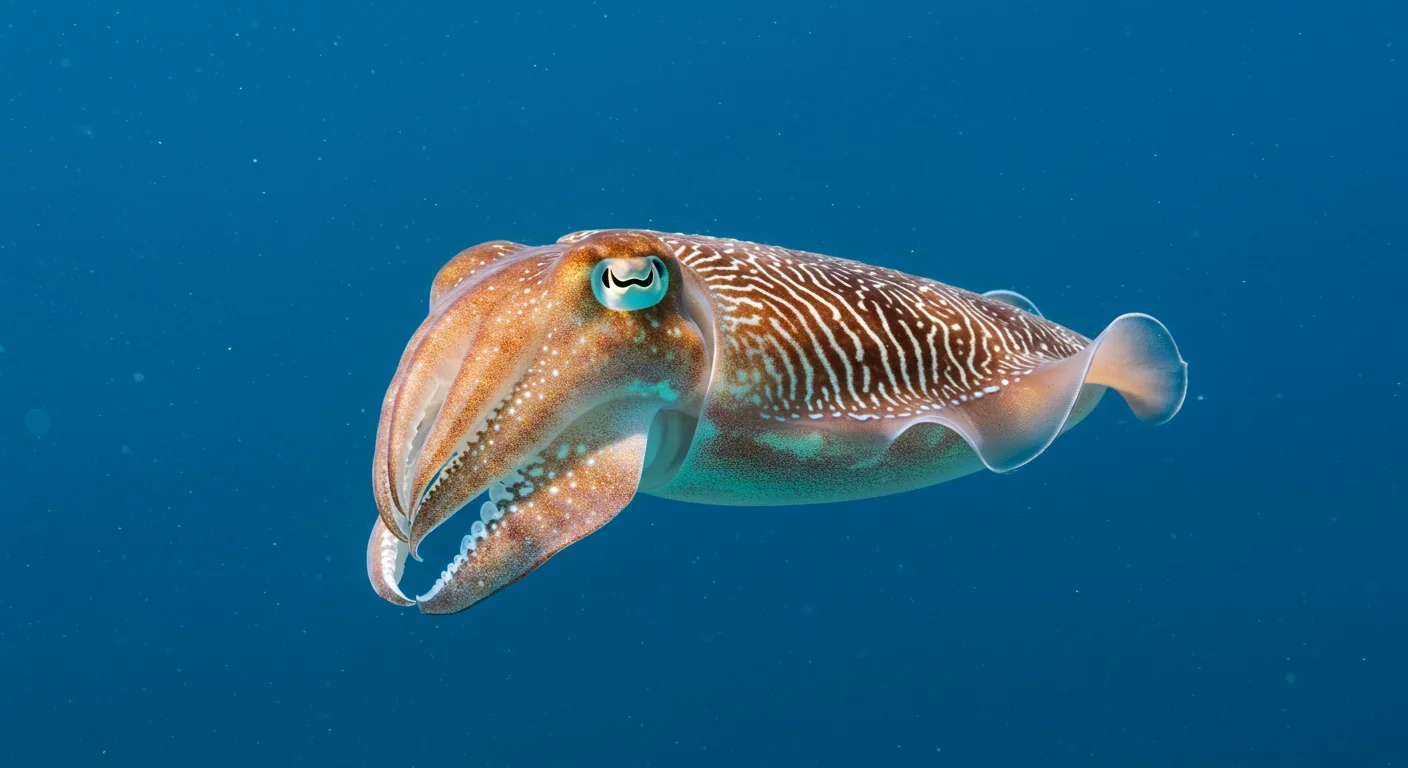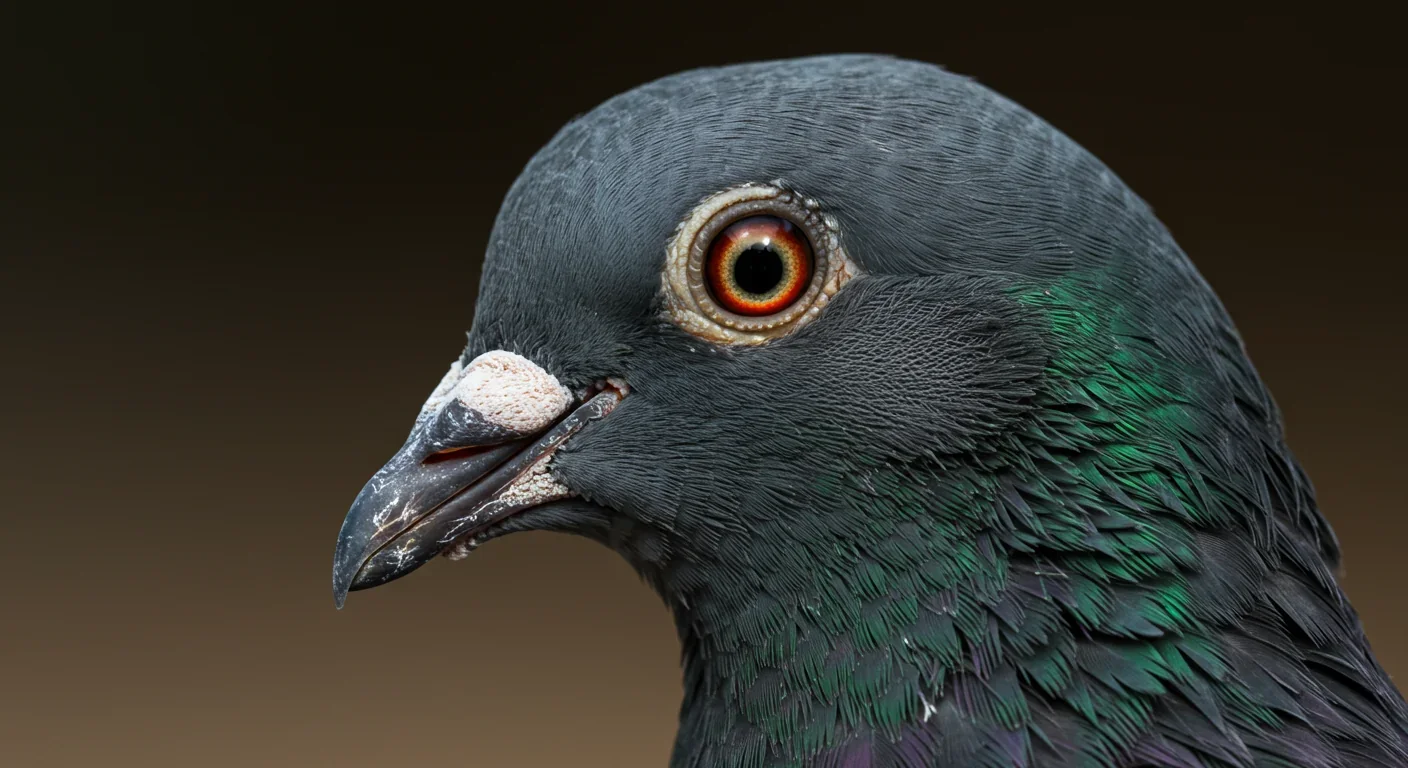Cuttlefish Pass Marshmallow Test: Alien Intelligence Decoded

TL;DR: Homing pigeons use microscopic magnetite crystals in their beaks as biological compass needles to sense Earth's magnetic field. These iron-rich crystals physically rotate with magnetic fields, triggering neural signals that help pigeons navigate across hundreds of miles with remarkable precision.
When a pigeon released 500 miles from home flies a near-perfect route back to its loft, it's doing something humans still can't replicate without technology. The bird is sensing an invisible force field that surrounds our planet, reading Earth's magnetic lines like a living GPS. Scientists have discovered that magnetite crystals embedded in pigeons' beaks act as biological compass needles, but the story of how we figured this out reveals one of nature's most elegant navigation systems and a scientific mystery that took decades to solve.

For centuries, humans used homing pigeons to carry messages across vast distances, but we had no idea how they found their way home. The breakthrough came when researchers at the University of Frankfurt discovered iron-rich structures in the upper beak of pigeons and other migratory birds. These weren't random deposits. Under electron microscopes, scientists identified clusters of magnetite (Fe₃O₄), an iron oxide mineral with powerful ferromagnetic properties.
Magnetite is the same mineral that ancient navigators used in the first compasses, making it the perfect biological sensor for detecting Earth's magnetic field. The crystals in pigeon beaks measure just 1-5 micrometers across, small enough to fit dozens inside a single human cell, yet powerful enough to align with the planet's magnetic field lines.
What makes this discovery remarkable isn't just that birds have these crystals, but where they're located and how they're connected to the nervous system. The magnetite sits in specialized cells in the upper beak's skin, precisely positioned to sense magnetic field direction and intensity. When researchers at the University of Auckland examined these structures, they found the crystals clustered in a region rich with nerve endings from the trigeminal nerve, the same nerve that gives you sensation in your face.
The magnetite crystals in a pigeon's beak are just 1-5 micrometers across—small enough that dozens could fit inside a single human cell, yet powerful enough to detect Earth's magnetic field.
The mechanism is elegantly simple in concept but incredibly sophisticated in execution. Magnetite crystals behave like tiny bar magnets, aligning themselves with Earth's magnetic field just like a compass needle points north. As the bird changes direction, these crystals rotate, creating mechanical stress on the surrounding tissue.
Here's where it gets clever. The magnetite crystals are embedded in or attached to mechanosensitive ion channels in the cell membranes. When the crystals move in response to the magnetic field, they physically pull or push on these channels, causing them to open. This allows charged particles (ions) to flow across the cell membrane, generating an electrical signal.
Think of it like a microscopic switch that gets flipped by magnetic forces. The trigeminal nerve carries these electrical signals to the brain, where specialized regions process the magnetic information and integrate it with other navigational cues. Scientists discovered that when they temporarily blocked the trigeminal nerve in pigeons, the birds lost their ability to orient themselves using magnetic fields but could still navigate using visual landmarks and the sun.
The system provides two types of information. The inclination angle (the angle at which magnetic field lines enter the Earth) tells the bird its latitude, essentially how far north or south it is. The intensity of the field provides additional positional information. Together, these readings give the pigeon a magnetic map of its location.

Science demands evidence, and the magnetite theory faced rigorous testing. In one of the most elegant experiments, researchers attached small magnets to pigeons' heads before releasing them. The artificial magnetic fields completely disrupted the birds' navigation on overcast days when they couldn't use the sun for orientation. Control birds with non-magnetic brass bars attached to their heads flew home without problems.
Another breakthrough came from electromagnetic pulse experiments. Scientists exposed pigeons to brief, strong magnetic pulses designed to remagnetize or disrupt the magnetite crystals. Birds that received these pulses showed significant navigation deficits, particularly in unfamiliar territory where they couldn't rely on learned landmarks.
Researchers at the University of North Carolina went further, using functional MRI scans to watch pigeon brains in action. They found that specific brain regions lit up when the birds were exposed to changing magnetic fields, confirming that the signals from beak magnetite were reaching the brain and being processed.
But science rarely gives us simple answers. Just when researchers thought they'd solved the mystery, competing evidence emerged.
"The iron deposits weren't in nerve cells at all. They were in macrophages, immune cells that accumulate iron from dead red blood cells."
— Researchers examining iron-rich cells in pigeon beaks, 2012
In 2012, a team of researchers examined the iron-rich cells in pigeon beaks using advanced techniques and dropped a bombshell. The iron deposits weren't in nerve cells at all. They were in macrophages, immune cells that naturally accumulate iron from dead red blood cells. These cells, the researchers argued, couldn't transmit neural signals and therefore couldn't function as magnetic sensors.
This finding didn't disprove magnetic sensing in pigeons; the behavioral evidence was too strong. Instead, it suggested scientists might be looking at the wrong mechanism entirely. Enter the cryptochrome hypothesis.
Cryptochromes are light-sensitive proteins found in many animals, including birds. When blue light hits these molecules in the retina, it creates pairs of free radicals whose chemical reactions are sensitive to magnetic fields. This quantum mechanical process could let birds literally see magnetic fields as patterns of light and dark overlaid on their visual field.
Recent research suggests both systems might be at work. The cryptochrome system in the eyes could provide a compass sense telling the bird which direction is magnetic north, while magnetite-based sensors in the beak might provide a map sense, giving information about the bird's position. This dual-system model would explain why disrupting either mechanism affects navigation but doesn't completely eliminate it.

Pigeons aren't relying solely on magnetic sensing. They're integrating multiple information sources into a sophisticated navigation system that would make modern GPS designers jealous.
On sunny days, pigeons use the sun as a compass, compensating for its movement across the sky with their internal circadian clock. They can detect polarized light patterns in the sky, visible even when the sun itself is obscured. Their sense of smell is surprisingly important too, particularly for recognizing familiar areas near home.
Visual landmarks become crucial as birds approach their destination. Pigeons released repeatedly from the same location learn the landscape, memorizing roads, rivers, and other features. But here's what's fascinating: even on their first flight from an unfamiliar release point, pigeons can often navigate home using their magnetic sense and sun compass without any prior knowledge of the route.
Low-frequency sound waves, called infrasound, travel hundreds of miles through the atmosphere. Pigeons can hear these sounds, which carry information about distant geographic features like coastlines and mountain ranges. Some researchers believe birds use these acoustic landmarks as part of their navigational toolkit.
The real marvel is how the pigeon brain integrates all these disparate cues into a coherent sense of location and direction. Different brain regions process each type of information, and higher-level areas synthesize them into a unified navigational decision. When one sense is unavailable—overcast blocking the sun, for instance—the bird seamlessly relies more heavily on other cues.
Pigeons integrate magnetic sensing with sun position, polarized light patterns, smell, visual landmarks, and even infrasound into a navigation system more sophisticated than modern GPS.
Our technological world creates challenges for magnetic navigators. Power lines generate electromagnetic fields that can confuse birds' magnetic sense. Researchers found that migratory birds become disoriented when crossing areas with high-voltage lines, particularly during periods when their magnetic compass is most critical for navigation.
Radio and cellular towers emit electromagnetic radiation across a broad spectrum. While the long-term effects are still being studied, some research suggests these artificial fields interfere with cryptochrome-based magnetic sensing. Birds navigating through areas with dense electronic infrastructure show higher rates of navigation errors.
Solar storms present natural disruptions. When the sun ejects massive amounts of charged particles toward Earth, these geomagnetic storms distort the planet's magnetic field. Bird navigation suffers during these events. Racing pigeon fanciers have long known that birds released during geomagnetic disturbances often get lost, with some flocks experiencing dramatically lower return rates.
Climate change adds another layer of complexity. As Earth's magnetic field naturally wanders—the north magnetic pole has been drifting faster in recent decades—birds must update their internal maps. Young birds learning migration routes encode magnetic information that may be outdated by the time they're adults, potentially contributing to population declines in some migratory species.

Pigeons aren't alone in their magnetic superpowers. The biological magnetite compass has evolved independently multiple times across the animal kingdom, a classic case of convergent evolution where different species arrive at the same solution.
Migratory songbirds use magnetoreception during their incredible journeys. The tiny blackpoll warbler, weighing less than half an ounce, flies nonstop from New England to South America, using magnetic cues to navigate across thousands of miles of open ocean.
Sea turtles navigate using Earth's magnetic field to return to the exact beaches where they were born. They imprint on the magnetic signature of their natal beach as hatchlings and use that memory to find their way back decades later to lay their own eggs. Researchers have found magnetite crystals in turtle brains, suggesting a similar iron-based mechanism.
Even bacteria get in on the action. Magnetotactic bacteria contain chains of magnetosome crystals that act like intracellular compass needles, helping these microscopic organisms orient themselves in sediments to find optimal oxygen levels. These bacterial magnetosomes may have been the evolutionary precursor to the more complex magnetoreception systems in larger animals.
Insects, fish, and marine mammals also show evidence of magnetic sensing. Rainbow trout have magnetite crystals in their olfactory tissues. Honey bees appear to use magnetic cues for navigation and communication. Even cows and deer tend to align their bodies along magnetic field lines when resting, though whether this serves a function or is just a side effect of magnetic sensing isn't clear.
"We can describe magnetoreception mechanistically, but truly understanding what it feels like to sense magnetic fields remains beyond our reach. Birds may experience it visually or as an entirely unique sensation we can't even imagine."
— Contemporary neuroscience perspective on sensory experience
The discovery of magnetoreception fundamentally changed our understanding of animal sensory capabilities. We'd always known about the traditional five senses, but magnetoreception represents an entirely different category of perception, one that operates outside human experience.
This has philosophical implications. How do you explain color to someone who's been blind from birth? Similarly, we can describe magnetoreception mechanistically, but truly understanding the subjective experience—what it feels like to sense magnetic fields—remains beyond our reach. Birds may experience magnetic information visually, as a sort of overlay on their vision, or it might be an entirely unique sensation we can't even imagine.
From an engineering perspective, nature solved the magnetoreception problem with elegant simplicity. While human GPS systems require satellites, atomic clocks, and complex signal processing, a pigeon accomplishes similar navigation with microscopic crystals and specialized neurons. Bioengineers are studying these systems to develop new navigation technologies, particularly for applications where GPS is unavailable, like underwater or underground.
The medical implications are intriguing too. Some researchers are investigating whether humans retain vestigial magnetoreception capabilities. While we don't consciously sense magnetic fields, studies have found magnetic crystals in human brains and some evidence that people can unconsciously detect magnetic field changes. Whether this serves any function remains hotly debated.

Major questions remain unanswered. The exact molecular mechanism by which magnetite crystals connect to ion channels isn't fully understood. Scientists are working to identify the specific proteins involved and how mechanical forces from the crystals translate into electrical signals with enough precision to detect Earth's weak magnetic field.
The debate between magnetite and cryptochrome mechanisms continues. Recent studies using advanced neuroimaging and molecular biology techniques are mapping out distinct pathways for different magnetic information. The emerging consensus suggests specialized subsystems for compass orientation versus positional mapping, possibly using different sensing mechanisms.
Researchers are also investigating how young birds calibrate their magnetic sense. There's evidence they use celestial cues during development to set their internal compass, essentially cross-referencing the stars against magnetic field direction. Understanding this calibration process could explain how migratory routes are learned and passed between generations.
Climate change introduces urgency to this research. As magnetic field patterns shift and habitats change, understanding how birds navigate becomes crucial for conservation. Some species may adapt by updating their magnetic maps, while others could face population declines if they can't adjust quickly enough.
The military has long been interested in magnetoreception for developing navigation systems that work when GPS fails. Submarines, underground facilities, and aerospace applications could all benefit from bio-inspired magnetic navigation. Some research groups are working on artificial magnetoreceptors that mimic the pigeon beak system.
Conservation efforts increasingly rely on understanding animal navigation. Bird migration routes cross continents, making international cooperation essential for protecting stopover habitats and addressing threats like light pollution and electromagnetic interference. Knowing how birds navigate helps conservationists predict which areas are critical and how human activities might disrupt migration.
There's a broader lesson here about scientific progress. The magnetite hypothesis initially seemed to solve the mystery of bird navigation, then was challenged by contradictory evidence, leading to the cryptochrome theory, which in turn has been refined into a more nuanced dual-mechanism model. This isn't science flip-flopping; it's the iterative process of building increasingly accurate models of reality.
The pigeon in your local park, dismissed by many as a pest, is actually a sophisticated navigation machine carrying millions of years of evolutionary refinement in its DNA. Those tiny magnetite crystals in its beak connect it to Earth's magnetic field in a continuous dance of orientation and positioning, enabling navigational feats that still humble our best technology.
Every time a pigeon flies home from hundreds of miles away, it's demonstrating a biological capability that we're only beginning to understand. The iron-rich crystals in its beak are reading Earth's invisible force field, translating magnetic information into neural signals, and guiding the bird along a route it somehow knows leads to home. It's one of nature's most remarkable adaptations, hidden in plain sight on every city street and park bench, waiting for us to fully decode its secrets.

Curiosity rover detects mysterious methane spikes on Mars that vanish within hours, defying atmospheric models. Scientists debate whether the source is hidden microbial life or geological processes, while new research reveals UV-activated dust rapidly destroys the gas.

CMA is a selective cellular cleanup system that targets damaged proteins for degradation. As we age, CMA declines—leading to toxic protein accumulation and neurodegeneration. Scientists are developing therapies to restore CMA function and potentially prevent brain diseases.

Intercropping boosts farm yields by 20-50% by growing multiple crops together, using complementary resource use, nitrogen fixation, and pest suppression to build resilience against climate shocks while reducing costs.

Cryptomnesia—unconsciously reproducing ideas you've encountered before while believing them to be original—affects everyone from songwriters to academics. This article explores the neuroscience behind why our brains fail to flag recycled ideas and provides evidence-based strategies to protect your creative integrity.

Cuttlefish pass the marshmallow test by waiting up to 130 seconds for preferred food, demonstrating time perception and self-control with a radically different brain structure. This challenges assumptions about intelligence requiring vertebrate-type brains and suggests consciousness may be more widespread than previously thought.

Epistemic closure has fractured shared reality: algorithmic echo chambers and motivated reasoning trap us in separate information ecosystems where we can't agree on basic facts. This threatens democracy, public health coordination, and collective action on civilizational challenges. Solutions require platform accountability, media literacy, identity-bridging interventions, and cultural commitment to truth over tribalism.

Transformer architectures with self-attention mechanisms have completely replaced static word vectors like Word2Vec in NLP by generating contextual embeddings that adapt to word meaning based on surrounding context, enabling dramatic performance improvements across all language understanding tasks.